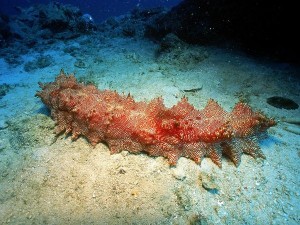You have heard the proverb, honesty is the best policy. These wise words seem to extend to the animal kingdom as well, as the sea cucumber’s behaviour demonstrates: for the sea cucumber, spilling its guts – pun intended – can save its life.
Sea cucumbers are marine animals that belong to Phylum Echinodermata and are of the class Holothuirodea. Now, appearances are deceiving. The cooked sea cucumber you usually encounter may appear monumentally boring but it has a quirky natural defence that will either enthral you or make you retch in response.
Here’s a video of an intentionally provoked sea cucumber, with a background commentary that does not reflect the most brilliant of humans:
(please do not provoke sea cucumbers in real life just to watch them vomit)
When threatened, most species of sea cucumbers may expel all or parts of their internal organs through the mouth or anus, in order to distract or scare their predator away. For some species, toxins may also be released during this process of evisceration. Some sea cucumbers may expel sticky toxic strings called Cuvieran tubules which either poison the predator or immobilise it, giving the sea cucumber ample time to escape. Like its relative, the starfish, sea cucumbers can regenerate their internal organs over one to five weeks.
Besides being the Claire Bennets of the Sea, sea cucumbers play a significantly fundamental role in deep sea ecosystems. Their diet of detritus contributes to nutrient recycling and their larvae are part of the plankton-based food chains. However, sea cucumbers, especially the edible ones, are at risk of being overharvested. In addition, land reclamation leading to habitat loss also threatens the survival of these animals. Without sea cucumbers, ecological systems will be upset and our very own survival placed at stake.
Therefore, save the sea cucumber, save the world.
References:
VandenSpiegel, D., M. Jangoux & P. Flammang, 2000. Maintaining the line of defense: regeneration of Cuvierian tubules in the sea cucumber Holothuria forskali (Echinodermata, Holothuroidea). The Biological Bulletin, 198 (1): 34-49.
“Shedding New light on the Humble Sea Cucumber,” by N. Alcock. Aquatic Biodiversity & Biosecurity Update, 2003. Hosted on National Insitute of Water & Atmospheric Research: http://www.niwa.co.nz/news-and-publications/publications/all/abb/2003-03/cucumber (accessed on 6 April 2010).
“Sea cucumbers (Holothuroidea) on the Shores of Singapore,” by Ria Tan. WildFactSheets, December 2008. Hosted on WildSingapore: http://www.wildsingapore.com/wildfacts/echinodermata/holothuroidea/holothuroidea.htm (accessed on 6 April 2010).
“Sea cucumber spills its guts,” by danyoferit. Youtube Channel, 29 December 2008. URL: http://www.youtube.com/watch?v=Ux6XiMAebn8&feature=related (accessed on 6 April 2010).
“Sea cucumber,” by Jack Jackson. National Geographic: Sea Cucumbers. URL: http://animals.nationalgeographic.com/animals/invertebrates/sea-cucumber (accessed on 6 April 2010).

